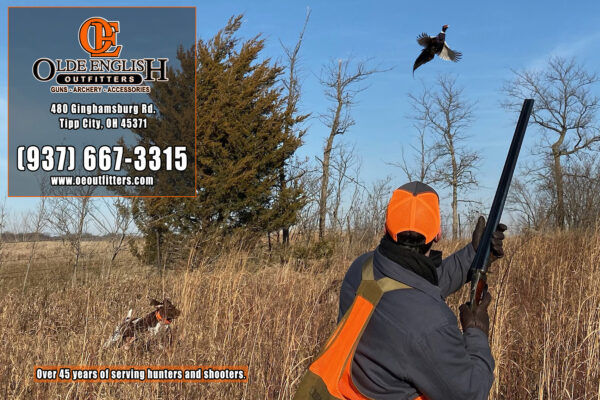Whether it’s the lack of time, or a change in culture, what we once enjoyed for crop maintenance and a way to hone skills for bigger, and better hunting has gone by the boards.
By Ray Reilly for Press Pros
 Someone wrote a long time ago…careful what you wish for. It might come true!
Someone wrote a long time ago…careful what you wish for. It might come true!
That person probably wasn’t a hunter, and that person probably wasn’t a farmer, or gardener.
He probably never had a soybean field ravaged by groundhogs, who would emerge from their underground dens long enough to get their daily need of tender young bean sprouts before they come close to bloom and maturity. Someone once guessed that a colony of groundhogs (woodchucks) was worth fifty bushels of soybeans come harvest time…from foraging early in the summer.
When I was a teenager a local farmer once gave me permission to target shoot on his property, with this caveat.
“Ray,” he said. “Why don’t you make it worth my while. Shoot as many of those groundhogs as you can. It’ll make me money and you a better a better shot.”
 Eager to please, I quickly found that it was easier said than done. First, groundhogs are very wary creatures with a sixth sense about safety. They can hear a twig snap at a hundred yards and don’t mind waiting until the threat is gone. Second, if there are more than one, all it takes is one to see or hear danger and give the signal. When that happens, they all disappear until it’s safe to come out. So I learned to observe within a half hour the exact time they came out to feed, and be there waiting as they emerged.
Eager to please, I quickly found that it was easier said than done. First, groundhogs are very wary creatures with a sixth sense about safety. They can hear a twig snap at a hundred yards and don’t mind waiting until the threat is gone. Second, if there are more than one, all it takes is one to see or hear danger and give the signal. When that happens, they all disappear until it’s safe to come out. So I learned to observe within a half hour the exact time they came out to feed, and be there waiting as they emerged.
It’s true that groundhogs are a great way to learn to be a better hunter. You learn the terrain, you learn how to position yourself for a better opportunity for a shot, and you learn to make that shot count once it happens.
Back then I hunted them with a bolt-action Remington .22 rifle that belonged to my dad. It was adequate, of course. Groundhogs are not that hard to bring down. Nowadays, hunters used high-powered calibers with scopes that allow for shots from a hundred yards or more. But it’s not necessary, just more challenging.
Using open sights on that Remington, I tried to position myself withing thirty yards of a den, and then….wait!
If you want to hunt groundhogs you learn to appreciate the waiting game, because without you knowing it they know you’re there, regardless of how quiet you are. They can literally hear your footsteps above ground while they’re underground. Sound and vibration serve them well as a natural alarm system. So you get there early, you sit silently, and you just wait.
Once they come out they’ll look around for danger, the wariest of any wild species I’ve ever hunted. They may look right at you. And if that happens you don’t move a muscle – barely breathe or blink. Any motion alerts them to danger and back in the hole they go.
But if they’re convinced it’s safe they quickly begin to feed, and that’s your opportunity to aim and shoot. And from thirty yards it’s still not a sure thing because they move, and they’ll chew with their heads on a swivel. They take nothing for granted for safety’s sake. If you have a scoped rifle a clean head shot is the most ethical. When I was young, using open sights, I settled for any contact I could make, wounding a few that made it back to the hole…that probably never back to the bean field.
Those were fun times, and thrilling to a youngster learning to hunt. Those lessons served me well later, during squirrel season. And when I got older and more advanced as a hunter I would adapt many of the same techniques in quest of whitetail deer. But I haven’t chased ’em – woodchucks – now for a long time.
When you get older your tastes in hunting become more sophisticated, and the challenge is more enticing to hunt bigger and more challenging game. It’s just how it is.
But groundhogs are still a great way to learn, if you can find them. When I was young they were a nuisance. Nowadays, they’re a novelty to even find. They have very few natural predators, except distemper. But in modern Ohio if you want to hunt ‘chucks now you have competition, and one I never suspected at fifteen. Now, the coyotes keep them in check to the point where it’s rare to even see a groundhog den, much less the groundhog, itself.
And Coyotes have become a bigger problem for many farmers than groundhogs ever were. A coyote, or a pack of them, can actually bring down a young calf or a sheep. They can kill the family dog or cat. In many areas they’ve all but wiped out the cottontail rabbit population, and coyotes are blamed for making it harder to re-establish many game bird populations. They prey on anything that nests, or moves on the ground, and when they wipe that out they move closer to civilization for urban dogs and cats.
It’s been years since my last groundhog, and the last time I asked a farmer about a threat to the bean crop he shook his head and said, “I haven’t seen one all year. I don’t know what happen to them.”
Careful what you wish for!
Chances are it wasn’t teenage boys with a .22. No one’s that hard up for entertainment now, and it’s not nearly exciting enough for the modern adolescent quest for thrills.
Now we’re hunting the hunter – coyotes – and that’s a whole ‘nuther game we’ll write about in a future column. Until then, fond memories of hunting ‘chucks, and that Remington.
‘Til then, I’ve enjoyed it.



